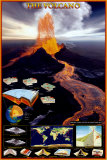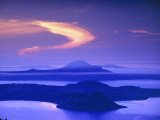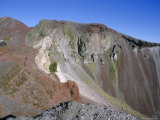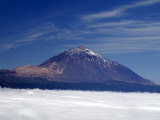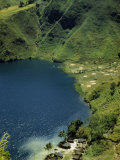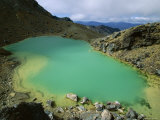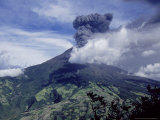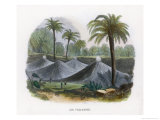|
|
|
|
|
The stratovolcano, Taal, is located in the Philippines' Lake Taal, water held in a caldera formed by an earlier and very powerful eruption - in effect a volcano island with 47 overlapping cones and craters.
Taal's most recent activity began in the early 1990s with the formation of small mud pots and mud geysers.
Taal is a Decade Volcano.
|
|
|
|
Tambora, in the volcano rich Indonesian archipelago, was the site of the most deadly eruption of a volcano in historical records occured in April of 1815.
Tambora is also credited with altering the global climate, making the year 1816 known as the Year Without a Summer in the Northern Hemisphere.
The bad weather in Europe is responsible for a group of writers hibernating during their summer holiday and challenging one another to write the scariest story - the result was Frankenstein by Mary Shelley.
|
|
|
|
Tarawera is the site of New Zealand's largest historic eruption (1886) that killed over a hundred people.
The eruption also obliterated the Pink and White Terraces. The terraces were geologic features formed by geothermally heated water that contained large amounts of silicic acid and sodium chloride flowing from geysers into Lake Rotomahana. The new Lake Rotomahana, 30 meters higher and much larger than the old lake, covers the formation.
|
|
|
|
Another Decade Volcano is El Teide, located on Tenerife, Canary Islands. Currently dormant, El Teide last erupted in 1909. The volcano is surrounded by a national park that is a UNESCO World Heritage site.
Explorer Christopher Columbus reported seeing “... A great fire” as he sailed past Tenerife on his voyage to discover the New World in 1492. This was interpreted as he had witnessed an eruption.
FYI ~ The Canary Islands are located just off the northwest coast of Africa. They are administered by Spain.
|
|
|
|
Toba, on Sumatra, was the site of a supervolcanic eruption that was a massive climate-changing event.
Some anthropologist and archeologists believe that the eruption, approximately 70,000 years ago, killed most humans then alive and resulted in a “population bottleneck in Central Eastern Africa and India that affected the genetic inheritance of all humans today”.
|
|
|
|
Mount Tongariro is a volcanic complex in the North Island of New Zealand in the Tongariro National Park.
The park is New Zealand's first national park, one of the earliest in the world and also a UNESCO World Heritage Site “for its outstanding natural and intangible cultural values”.
|
|
|
|
Tungurahua, or “Throat of Fire”, is an active stratovolcano located 87 miles south of Quito, Ecuador.
The volcano has been erupting since 1999 after a long period of rest. An eruption on December 18, 2012 forced the evacuation of those living on the volcano's slopes.
|
|
|
|
Air volcanoes are “eruptive sometimes volcanic opening in the earth from which large volumes of gas are discharged along with mud and stones”, as opposed to a mud volcano, “an orifice in the earth from which gas or vapor issues either through a pool of mud or with the ejection of mud which may accumulate in a conical mound.”
|
|
|
previous page | top | next
volcanoes > a | b | c | d | e | f-g | h-i-j | k | l | m | n-o | p | q-r | s | T | u-v | w-z
|
|
I have searched the web for visual, text, and manipulative curriculum support materials - teaching posters, art prints, maps, charts, calendars, books and educational toys featuring famous people, places and events - to help teachers optimize their valuable time and budget.
Browsing the subject areas at NetPosterWorks.com is a learning experience where educators can plan context rich environments while comparing prices, special discounts, framing options and shipping from educational resources.
Thank you for starting your search for inspirational, motivational, and educational posters and learning materials at NetPosterWorks.com. If you need help please contact us.
|
|
|




